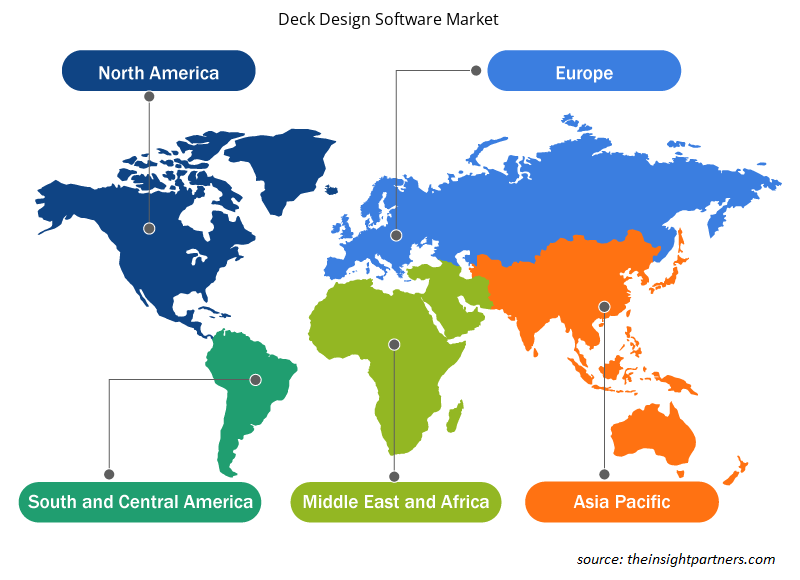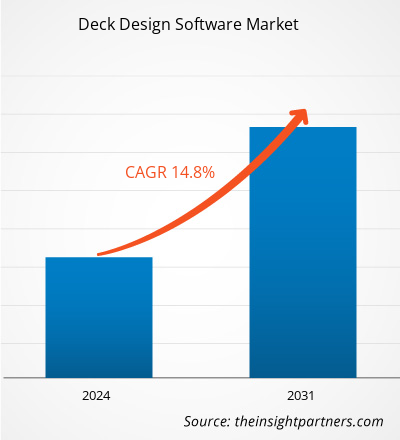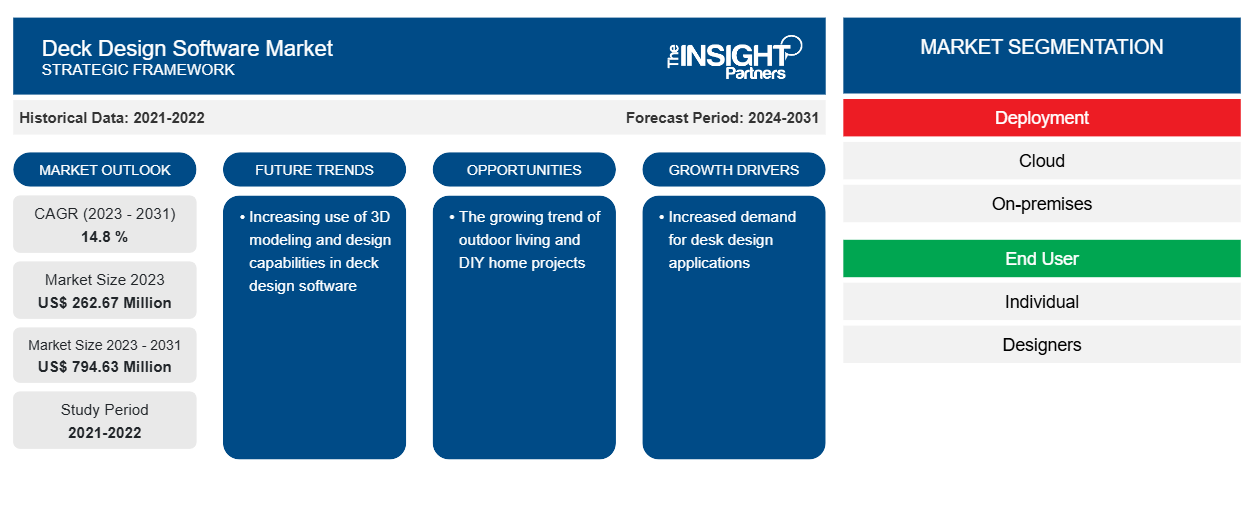Si prevede che la dimensione del mercato del software di progettazione di ponti raggiungerà i 794,63 milioni di dollari entro il 2031, rispetto ai 262,67 milioni di dollari del 2023. Si prevede che il mercato registrerà un CAGR del 14,8% nel 2023-2031. È probabile che l'uso crescente di capacità di progettazione e modellazione 3D nel software di progettazione di ponti rimanga una tendenza chiave del mercato del software di progettazione di ponti.
Analisi di mercato del software di progettazione di ponti
Si prevede che l'uso crescente di questi strumenti nei settori dell'edilizia e della ristrutturazione di case determinerà una crescita significativa nel mercato globale dei software di progettazione di ponti. Sempre più persone stanno tentando di rinnovare le proprie aree abitative all'aperto. Si prevede che il mercato crescerà a seguito della crescente popolarità dei ponti esterni e dell'accessibilità di strumenti per ponti ad alta tecnologia. Inoltre, si prevede che le crescenti preoccupazioni sulla sicurezza a seguito di calamità naturali possano aumentare la domanda di software di progettazione di ponti. Il software di progettazione di ponti sta crescendo in popolarità mentre il settore si dirige verso un futuro più meccanizzato e digitalizzato. I professionisti lo utilizzano frequentemente per le sue numerose funzionalità, che includono visualizzazione 3D , stesura automatica e gestione efficace dei progetti.
Panoramica del mercato del software di progettazione di ponti
Uno strumento elettronico per la pianificazione, la progettazione e la visualizzazione di ponti esterni è il software di progettazione ponti. Con l'aiuto di questo tipo di software, puoi realizzare, modificare e progettare ponti in una varietà di dimensioni e forme. Puoi anche scattare foto del progetto 3D e inviarle a clienti o colleghi. Per garantire che le strutture dei ponti soddisfino gli standard del settore e le normative di sicurezza, il software di progettazione ponti è stato utilizzato anche nel processo di ingegneria.
Personalizza questo report in base alle tue esigenze
Riceverai la personalizzazione gratuita di qualsiasi report, comprese parti di questo report, o analisi a livello nazionale, pacchetto dati Excel, oltre a usufruire di grandi offerte e sconti per start-up e università
-
Scopri le principali tendenze di mercato in questo rapporto.Questo campione GRATUITO includerà analisi di dati che spaziano dalle tendenze di mercato alle stime e alle previsioni.
Driver e opportunità del mercato del software di progettazione di ponti
Aumento della domanda di applicazioni di progettazione di scrivanie
La necessità di applicazioni di progettazione di ponti sta crescendo poiché sempre più proprietari di case e appaltatori vogliono essere in grado di pianificare e immaginare i loro ponti prima di iniziare a costruirli. Con il software di progettazione di ponti, gli utenti possono modificare rapidamente e facilmente le dimensioni o la forma del ponte, sperimentare numerose possibilità di progettazione e vedere il prodotto finito in tre dimensioni. Ciò facilita il processo di pianificazione e costruzione di ponti e riduce la necessità di costose discussioni di persona con gli appaltatori.
La tendenza crescente della vita all'aria aperta e dei progetti fai da te per la casa
Il software di progettazione di ponti sta diventando sempre più popolare a seguito delle tendenze in espansione della vita all'aria aperta e dei miglioramenti fai-da-te per la casa. Un numero crescente di proprietari di case sta realizzando progetti fai-da-te, come la costruzione di ponti e cucine all'aperto , per migliorare le proprie aree abitative all'aperto. Con l'uso del software di progettazione di ponti, i proprietari di case possono pianificare e visualizzare più facilmente e precisamente il proprio ponte prima di iniziare la costruzione, risparmiando potenzialmente denaro e tempo sul progetto. Pertanto, si prevede che la crescente adozione dell'IoT presenterà nuove opportunità per gli operatori del mercato del software di progettazione di ponti durante il periodo di previsione.IoT is anticipated to present new opportunities for the deck design software market players during the forecast period.
Analisi della segmentazione del rapporto di mercato del software di progettazione del ponte
I segmenti chiave che hanno contribuito alla derivazione dell'analisi di mercato del software di progettazione di ponti sono l'implementazione, l'utente finale e l'applicazione.
- In base all'implementazione, il mercato del software di progettazione di deck è segmentato in cloud e on-premise. Il segmento cloud ha detenuto una quota di mercato maggiore nel 2023.
In base all'utente finale, il mercato è segmentato in privati e designer.
- In base all'applicazione, il mercato è segmentato in residenziale e commerciale.
Analisi della quota di mercato del software di progettazione di ponti per area geografica
L'ambito geografico del rapporto di mercato sul software di progettazione di ponti è principalmente suddiviso in cinque regioni: Nord America, Asia Pacifico, Europa, Medio Oriente e Africa e Sud America/Sud e Centro America. In termini di fatturato, il Nord America ha rappresentato la quota di mercato più grande del software di progettazione di ponti. Oggigiorno, molte aziende forniscono software specificamente progettati per il mercato nordamericano, il che semplifica per i clienti la ricerca dell'articolo ideale per le loro esigenze. Inoltre, la crescente accessibilità delle risorse online sta spingendo il mercato. Per aiutarli a ottenere il massimo dal loro investimento, i consumatori possono ora accedere a una varietà di video, consigli e suggerimenti sull'utilizzo del software di progettazione di ponti.
Approfondimenti regionali sul mercato del software di progettazione di ponti
Le tendenze regionali e i fattori che influenzano il mercato del software di progettazione di ponti durante il periodo di previsione sono stati ampiamente spiegati dagli analisti di Insight Partners. Questa sezione discute anche i segmenti e la geografia del mercato del software di progettazione di ponti in Nord America, Europa, Asia Pacifico, Medio Oriente e Africa e America meridionale e centrale.

- Ottieni i dati specifici regionali per il mercato del software di progettazione del ponte
Ambito del rapporto di mercato sul software di progettazione del ponte
| Attributo del report | Dettagli |
|---|---|
| Dimensioni del mercato nel 2023 | 262,67 milioni di dollari USA |
| Dimensioni del mercato entro il 2031 | 794,63 milioni di dollari USA |
| CAGR globale (2023-2031) | 14,8% |
| Dati storici | 2021-2022 |
| Periodo di previsione | 2024-2031 |
| Segmenti coperti |
Per distribuzione
|
| Regioni e Paesi coperti |
America del Nord
|
| Leader di mercato e profili aziendali chiave |
|
Densità dei player del mercato del software di progettazione di ponti: comprendere il suo impatto sulle dinamiche aziendali
Il mercato del software di progettazione di ponti sta crescendo rapidamente, spinto dalla crescente domanda degli utenti finali dovuta a fattori quali l'evoluzione delle preferenze dei consumatori, i progressi tecnologici e una maggiore consapevolezza dei vantaggi del prodotto. Con l'aumento della domanda, le aziende stanno ampliando le loro offerte, innovando per soddisfare le esigenze dei consumatori e capitalizzando sulle tendenze emergenti, il che alimenta ulteriormente la crescita del mercato.
La densità degli operatori di mercato si riferisce alla distribuzione di aziende o società che operano in un particolare mercato o settore. Indica quanti concorrenti (operatori di mercato) sono presenti in un dato spazio di mercato in relazione alle sue dimensioni o al valore di mercato totale.
Le principali aziende che operano nel mercato del software per la progettazione di ponti sono:
- Prodotti edili AZEK (Tecnologia del legno)
- Architetto capo Inc.
- Delta Software International LLC (Professionista CAD)
- Fibra
- Spettro delle idee, Inc.
- Strumenti software Luxwood
Disclaimer : le aziende elencate sopra non sono classificate secondo un ordine particolare.

- Ottieni la panoramica dei principali attori del mercato dei software di progettazione di ponti
Notizie di mercato e sviluppi recenti del software di progettazione di ponti
Il mercato del software di progettazione di deck viene valutato raccogliendo dati qualitativi e quantitativi dopo la ricerca primaria e secondaria, che include importanti pubblicazioni aziendali, dati di associazioni e database. Di seguito è riportato un elenco degli sviluppi nel mercato dei disturbi e delle strategie del linguaggio e della parola:
- Nel 2021, la TimberTech Pro Reserve Collection è una nuova gamma di materiali compositi per decking introdotta dall'azienda. La serie ha una migliore resistenza all'umidità e alle macchie, una garanzia di 30 anni e un aspetto e una sensazione realistici del legno. Grazie alla varietà di colori e motivi della collezione, i consumatori possono sviluppare layout di deck personalizzati e distintivi. (Fonte: TimberTech, comunicato stampa)
- Nell'ottobre 2021, Fiberon ha annunciato il lancio di Deck Designer, la più recente aggiunta alla suite Discovery Deck Design Tools di risorse digitali interattive per proprietari di case e professionisti del settore. Deck Designer è uno strumento di progettazione 3D che facilita la progettazione di uno spazio abitativo all'aperto utilizzando l'intera offerta di prodotti per ringhiere, decking Fiberon e rivestimenti. (Fonte: Fiberon, comunicato stampa)
Copertura e risultati del rapporto di mercato sul software di progettazione di ponti
Il rapporto "Dimensioni e previsioni del mercato del software di progettazione del ponte (2021-2031)" fornisce un'analisi dettagliata del mercato che copre le seguenti aree:
- Dimensioni e previsioni del mercato a livello globale, regionale e nazionale per tutti i segmenti di mercato chiave coperti dall'ambito
- Dinamiche di mercato come fattori trainanti, vincoli e opportunità chiave
- Principali tendenze future
- Analisi dettagliata delle cinque forze PEST/Porter e SWOT
- Analisi di mercato globale e regionale che copre le principali tendenze di mercato, i principali attori, le normative e gli sviluppi recenti del mercato
- Analisi del panorama industriale e della concorrenza che copre la concentrazione del mercato, l'analisi della mappa di calore, i principali attori e gli sviluppi recenti
- Profili aziendali dettagliati
- Analisi storica (2 anni), anno base, previsione (7 anni) con CAGR
- Analisi PEST e SWOT
- Valore/volume delle dimensioni del mercato - Globale, Regionale, Nazionale
- Industria e panorama competitivo
- Set di dati Excel
Report recenti
Rapporti correlati
Testimonianze
Motivo dell'acquisto
- Processo decisionale informato
- Comprensione delle dinamiche di mercato
- Analisi competitiva
- Analisi dei clienti
- Previsioni di mercato
- Mitigazione del rischio
- Pianificazione strategica
- Giustificazione degli investimenti
- Identificazione dei mercati emergenti
- Miglioramento delle strategie di marketing
- Aumento dell'efficienza operativa
- Allineamento alle tendenze normative























 Ottieni un campione gratuito per - Mercato del software di progettazione di ponti
Ottieni un campione gratuito per - Mercato del software di progettazione di ponti